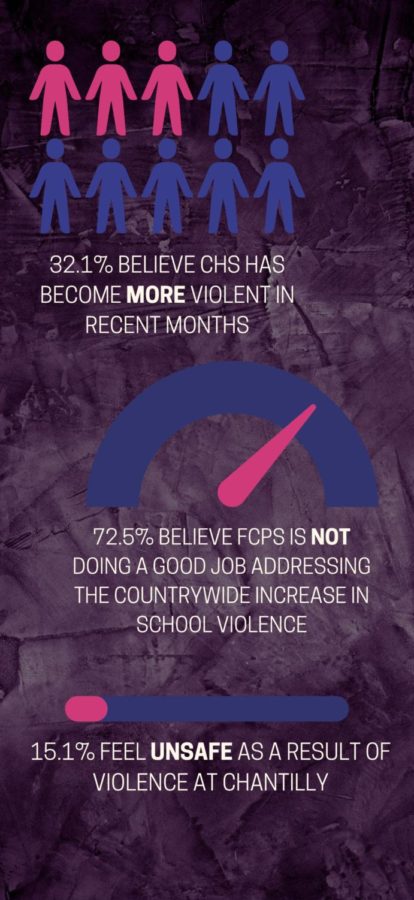Your donation will support the student journalists of Chantilly High School. Your contribution will allow us to cover our printing and annual website hosting costs.
Social, behavioral factors induce violent behavior
February 11, 2022
Cassie Barnes, Mahika Sharma, Roshni Ahuja
In a poll conducted via Google Forms from Jan. 21-25, 106 students were surveyed on their perception of violence at CHS and how it’s been handled in light of the nationwide increase.
According to a bulletin by the U.S. Department of Homeland Security (DHS), 91% of school attackers had visible mental conditions such as depression and cognitive deficits. Additionally, all of said attackers had experienced one or more “social risk factors,” characteristics that may increase an individual’s tendency to carry out violence, such as bullying or social exclusion, in the six months before they did so. Since many young people had to live in relative isolation as a result of coronavirus-related lockdowns, the DHS deems the pandemic a precursor of the recent uptick in school violence.
“Because of the pandemic, more distance between family members can cause students to not feel [like] themselves and their social skills could be diminished,” senior Shruthi Ganapuram said. “Not being able to talk to [people] and feeling alone are both factors that can perpetuate school violence.”
A troubled home life may similarly drive students to commit violence. In an interview with Lehigh University, counseling psychologist Peter Langman, Ph.D., stated that school shooters are often driven by anger out of being abused by family members, being in poverty or being repeatedly passed off from one guardian to another—in other words, there is a lack of stability in their domestic lives. Even perpetrators of less severe forms of school violence may lash out due to household dysfunction, per a journal article published by Frontiers in Psychology.
“Sometimes, there doesn’t appear to be an issue with [a student’s] family situation, so that is always kind of a surprise,” counselor Sarah Snyder said. “It’s interesting because there are so many factors that can affect whether someone [engages in violence]. There are external factors, like how their family members treat them, but how they perceive the world can be an internal factor as well.”
Substance abuse is another cause of aggression in many students. According to a 2006 study conducted by the Substance Abuse and Mental Health Services Administration, 45.6% of teenagers who had taken one illicit drug in the past year exhibited violent behavior, as opposed to 61.9% of those who had taken three or more illicit drugs in the same timeframe. These statistics demonstrate the influence of substance use on school violence as illegal drug use rises among teens.
“The first act of school violence I remember experiencing happened in my middle school and involved a couple of students that were trading drugs for some type of monetary compensation,” Ganapuram said. “I didn’t know how much of a perverse effect drug abuse has on school violence. It can definitely make not only students that are engaging in violent [behavior] but also those that hear about it feel unsafe on their own school grounds.”
There are several other triggers of youth-involved violence, states the Centers for Disease Control and Prevention, such as gang activity and easy access to weapons. However, if unchecked, this sort of abusive behavior can have adverse effects on not only the perpetrator and their victims but also the community at large.
“Across the board, school violence can look so different, but, regardless, it’s always a traumatic experience,” Snyder said. “If a student is at a place where they want to harm someone, I’d be working with the family, the school administration and our school psychologist to support them. We have ethical responsibilities—this is about people and everyone living their lives.”
